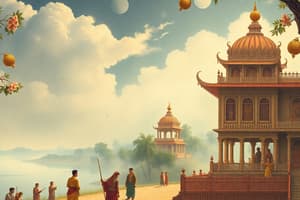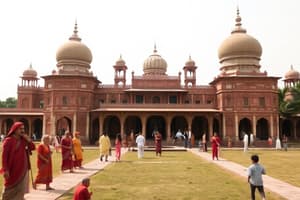Podcast
Questions and Answers
Which civilization influenced the region around the 3rd century BCE?
Which civilization influenced the region around the 3rd century BCE?
- Ahom Dynasty
- Kushite Empire (correct)
- Varmana Kingdom
- Pala Dynasty
What system did the Ahom Dynasty introduce for record-keeping?
What system did the Ahom Dynasty introduce for record-keeping?
- Zan Buranji
- Buranji (correct)
- Mikir Records
- Kachari Script
What economic change occurred in Assam as a result of British annexation in 1826?
What economic change occurred in Assam as a result of British annexation in 1826?
- Introduction of tea plantations (correct)
- Decline of agriculture
- Closure of trade routes
- Emphasis on traditional crafts
Which of the following leaders played a significant role in Assam's Freedom Movement?
Which of the following leaders played a significant role in Assam's Freedom Movement?
What is the most prominent festival in Assam that marks the agricultural cycle?
What is the most prominent festival in Assam that marks the agricultural cycle?
Which of the following was NOT a notable achievement of the Ahom Dynasty?
Which of the following was NOT a notable achievement of the Ahom Dynasty?
Which of these is a traditional Assamese cuisine characteristic?
Which of these is a traditional Assamese cuisine characteristic?
What challenge did Assam face after becoming a state in independent India?
What challenge did Assam face after becoming a state in independent India?
Study Notes
Ancient Civilizations
- Early Settlements: Evidence of habitation from the Neolithic era; presence of stone tools and pottery.
- Kushite Influence: The region saw influences from the Kushite Empire around the 3rd century BCE.
- Varmana Kingdom: Emerged in the 4th century CE; played a crucial role in Assam’s early political history.
- Pala and Kamarupa: Important dynasties that contributed to the cultural and political landscape.
Ahom Dynasty
- Establishment: Founded in 1228 by Sukapha; ruled for nearly 600 years.
- Military Strength: Known for strong military organization; significant resistance against Mughal invasions.
- Administration: Developed a bureaucratic system; introduced the "Buranji" system for record-keeping.
- Cultural Contributions: Promoted local culture, language, and traditions; introduced festivals like Bihu.
Colonial Impact
- British Annexation: Assam was annexed in 1826 after the First Anglo-Burmese War.
- Economic Changes: Introduction of tea plantations, leading to economic shifts; increased trade and migration.
- Social Reforms: Colonial rule brought about social changes, including educational reforms and infrastructure development.
- Resistance: Rise of local uprisings against British rule; notable movements include the Kachari and Mikir rebellions.
Freedom Movement
- Anti-Colonial Sentiment: Growing discontent in the late 19th and early 20th centuries; influenced by national movements.
- Key Figures: Leaders like Lokpriya Gopinath Bordoloi and Sarala Devi Choudhurani played significant roles.
- Participation: Assam was active in the Indian National Congress and the Quit India Movement.
- Post-Independence: Assam became a state in the newly independent India; faced challenges like ethnic conflicts and economic development.
Cultural Heritage
- Language and Literature: Assamese is the official language; rich literary tradition with notable poets and writers.
- Festivals: Bihu is the most prominent festival, marking the agricultural cycle; others include Rongali and Bhogali Bihu.
- Art and Music: Traditional arts include weaving and pottery; folk music, including Bihu songs, is widely celebrated.
- Cuisine: Known for rice-based dishes, fish, and green vegetables; distinct culinary practices reflect local biodiversity.
Ancient Civilizations
- Early settlements show evidence of habitation dating back to the Neolithic era, including stone tools and pottery artifacts.
- The Kushite Empire influenced the region around the 3rd century BCE, contributing to cultural exchange and development.
- The Varmana Kingdom emerged in the 4th century CE and played a pivotal role in the political history of Assam.
- Significant dynasties like Pala and Kamarupa added to the region's cultural and political complexity.
Ahom Dynasty
- Established in 1228 by Sukapha, the Ahom dynasty ruled Assam for nearly 600 years, marking a significant historical period.
- Known for its strong military organization, the Ahoms effectively resisted multiple Mughal invasions, safeguarding their territory.
- Developed a comprehensive bureaucratic system, pioneering the "Buranji" record-keeping method for administration.
- Actively promoted local culture, language, and traditions, with notable cultural contributions including the introduction of the Bihu festival.
Colonial Impact
- Assam was annexed by the British in 1826 following the First Anglo-Burmese War, marking a significant change in its governance.
- The establishment of tea plantations transformed the economy, leading to shifts in trade and increased migration to the region.
- Colonial rule introduced social reforms, including advancements in education and infrastructure development in Assam.
- Local uprisings against British rule emerged, with significant movements like the Kachari and Mikir rebellions highlighting resistance efforts.
Freedom Movement
- Rising anti-colonial sentiment in the late 19th and early 20th centuries was spurred by broader national movements across India.
- Key figures in the freedom struggle included Lokpriya Gopinath Bordoloi and Sarala Devi Choudhurani, who were instrumental in advocacy.
- Assam actively participated in national movements such as the Indian National Congress and the Quit India Movement.
- After gaining independence, Assam faced challenges related to ethnic conflicts and economic development as a newly recognized state.
Cultural Heritage
- Assamese is the state's official language, supported by a rich literary heritage featuring renowned poets and writers.
- Bihu stands out as the foremost festival in Assam, celebrating the agricultural cycle, along with Rongali and Bhogali Bihu.
- The region's traditional arts include weaving and pottery, while folk music, particularly Bihu songs, holds cultural significance.
- Cuisine emphasizes rice-based dishes, fish, and green vegetables, showcasing the biodiversity unique to the region's culinary practices.
Studying That Suits You
Use AI to generate personalized quizzes and flashcards to suit your learning preferences.
Description
Explore the fascinating early settlements and significant dynasties that shaped ancient Assam, including the Kushite influence and the Varmana Kingdom. Discover the establishment of the Ahom Dynasty, its military prowess, administrative innovations, and cultural contributions. Delve into the lasting effects of colonial impact on Assam's historical landscape.




